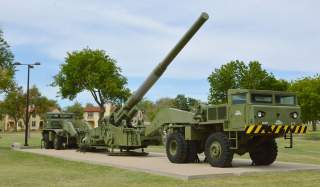The Army's New 1000-Mile Cannon Will Match The Navy And Air Force's Ranged Strike Capabilities
In layout, the Strategic Long-Range Cannon is similar to railway guns from the World Wars.
Key point: The Army also is working with the Navy to develop a common hypersonic glide vehicle, which would launch atop a rocket then travel 1,400 miles or farther at a top speed exceeding Mach 5.
The U.S. Army still is studying a concept for a gigantic new cannon that could fire shells as far as 1,000 miles.
The new Strategic Long-Range Cannon could give the ground-combat branch roughly the same kind of fast deep-strike capability that the U.S. Air Force and U.S. Navy possess with their warplanes and cruise missiles.
The Army’s Combat Capabilities Development Command in late February posted, on professional networking site Linkedin, an artist’s impression of the cannon. The image depicts an extremely large cannon on a trailer with at least six wheels, under tow by a heavy truck itself with at least eight wheels.
The Army lists the new gun’s range as being “beyond 1,000 miles.” Each cannon would require eight soldiers to operate it. A battery would number four guns. The cannons would be transportable by air and sea.
While larger in scale than any existing artillery piece, the Strategic Long-Range Cannon doesn’t actually require much in the way of new technology, Col. John Rafferty, who in 2018 led the Army’s long-range-fires modernization effort, told Breaking Defense.
Rafferty said the new gun would borrow elements of existing 155-millimeter cannons. “I don’t want to oversimplify, [but] it’s a bigger one of those,” Rafferty said. “We’re scaling up things that we’re already doing.”
The Strategic Long-Range Cannon is one of several new weapons the Army wants to help it match, and eventually exceed, the range and destructive power of North Korean, Russian and Chinese fires. The U.S. Army during the 2000s lagged behind its major rivals in artillery development.
That changed as China began exerting more influence in the Asia-Pacific region. The change accelerated when Russia invaded Ukraine in 2014. The Army deployed back to Europe two battalions of rocket launchers that it previously had withdrawn from the continent.
Now the Army is developing new, longer barrels for its M-109 self-propelled howitzers and M-198 towed howitzers. The service also is working on new rocket-propelled shells for both guns. The upgrades could boost the firing range of today’s howitzers from around 20 miles to at least 80 miles.
The service also is developing new rockets for its wheeled High-Mobility Artillery Rocket System and tracked Multiple-Launch Rocket System.
The current, standard Guided Multiple Launch Rocket System rocket flies as far as 43 miles. A new extended-range version of the GMLRS, which the Army hopes to field starting in 2020, flie more than twice as far.
The current, large-diameter Army Tactical Missile System, which also is compatible with HIMARS and MLRS, has a maximum range of 186 miles. The new, lighter Precision Strike Missile -- due to enter service in 2023 -- boasts a 310-mile max range.
The Army also is working with the Navy to develop a common hypersonic glide vehicle, which would launch atop a rocket then travel 1,400 miles or farther at a top speed exceeding Mach 5.
In range, the Strategic Long-Range Cannon fits between the Precision Strike Missile and the hypersonic missile. With the new gun, the Army could strike targets such as staging bases, logistical networks and air bases -- targets that, before, were the sole responsibility of Air Force and Navy planes and missiles.
In layout, the Strategic Long-Range Cannon is similar to railway guns from the World Wars. The German army’s Heavy Gustaf railway gun could fire a seven-ton shell nearly 30 miles.
The German built two of the Heavy Gustafs and deployed them on the Eastern Front for the sieges of Sevastopol, Leningrad and Stalingrad. The guns fired 48 shells in combat, demolishing some Soviet fortifications. It took thousands of men to deploy a Heavy Gustaf and 500 men just to fire it.
In 1945 the Germans spiked both guns, destroying them to prevent them falling into Allied hands.
The Army wants to demonstrate a prototype of the Strategic Long-Range Cannon in 2023, at which point it will decide whether to begin a formal program actually to field the gun.
David Axe serves as Defense Editor of the National Interest. He is the author of the graphic novels War Fix, War Is Boring and Machete Squad. This article first appeared last month.
Image: Creative Commons.

